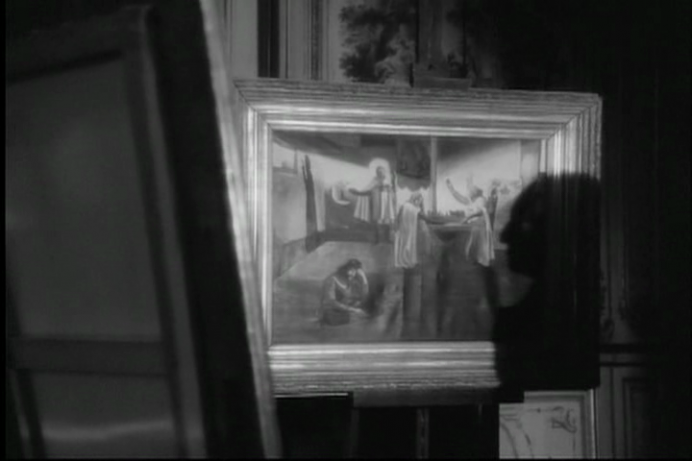Reviews
L’Hypothèse du tableau volé
Raúl Ruiz
France, 1979
Credits
Review by David Carter
Posted on 22 May 2014
Source Facets Video DVD
Related articles
Features
The End
The mystery genre began to take form in the early 1800s, but it would be naïve to presume that a preoccupation with secrecy and the act of exposing it had not been with us since the dawn of history. Mystery art — novels, plays, cinema — reflects humanity’s innate curiosity and our desire to possess the forbidden; in this case, knowledge. Raul Ruiz’s The Hypothesis of the Stolen Painting deals directly with this obsession for knowledge. The information the characters pursue is of no tangible value, and yet they frantically search for the truth, overwhelmed simply by their desire to know the answers denied them. Ruiz denies giving the audience a firm context for the film’s events, relying solely on their mutual curiosity with a mystery about which they know nothing.
The entirety of background information the audience receives comes via a brief bit of dialogue between the film’s two characters: the unnamed collector, and the unnamed and unseen narrator. The relation between the two men, the circumstances that brought them together, and their individual motives remain mysteries, but the task at hand does not. They are investigating the theft of a painting by the obscure artist Tonnerre. The work is important because it is part of a series of seven paintings that, when displayed, caused a Parisian scandal and were subsequently suppressed by the government. The reason the works would have been so inflammatory is not immediately evident to either man and it is determined that the mystery of the theft can only be solved once the greater mystery of the paintings’ meanings has been settled.
Having reached an impasse during their visual examination of the works, the men take a more direct approach, literally stepping inside the paintings through the use of living tableaus. The idea came to them through the examination of a rare letter from Tonnerre, in which he responded to authorities who had arrested a group attempting to create living tableaus of the seven paintings. Their gambit pays off, as the new perspective gives prominence to aspects of the works that would have gone unnoticed otherwise. As the men journey through the paintings, it becomes evident why the works were so scandalous, and why Tonnerre went to such great lengths to obfuscate their meaning.
Superficially Ruiz strictly adheres to the traditional mystery style of clues, suppositions, and deductions. He simultaneously plays with a more ancient definition of the term: that of the religious mystery. Mystery plays were historically about creation myths and other religious themes, and most often took the form of living tableaus, the primary visual device used in the film. More to the point, the men find that navigating the maze Tonnerre has constructed takes them on a journey through esoteric occult knowledge, beginning in the first painting with the Roman cult of Diana, goddess of the hunt. Diana’s painting leads the men next into the quasi-Islamism of the Knights Templar, human sacrifices, Parisian secret societies, and, ultimately, a suppressed cult that the men identify as the root of all cults and heresies. It is this aspect of the plot that helps The Hypothesis of the Stolen Painting expand well beyond the rigid borders Ruiz established through the limited characters and static setting. It positions the film’s puzzle as not simply a mystery, but as the ultimate mystery of history.
Although the main characters of The Hypothesis of the Stolen Painting would be best described as detectives, their methodology more closely conforms to the standards of academic inquiry than to those used by Sherlock Holmes and company. Ruiz perfectly illustrates the process of deconstructing a text, allowing his investigators to literally immerse themselves in the work to analyze not only how the individual elements relate to one another but also how they fit into the artist’s oeuvre. The men are content to let the paintings speak for themselves until they reach a brick wall, at which point they rely on related media—in this case, a novel written by Tonnerre. The novel provides the framework not only for the fifth painting, but for the collection as a whole, and, useful though it may be, the men are unsure if the novel is their Rosetta stone or simply another layer of the mystery.
The Hypothesis of the Stolen Painting can be a tough slog at times. The flat construction of scenes and the dominance of the singular on-screen character give the film the appearance of a lecture; an element that is exacerbated if one watches the dialogue-intensive film with subtitles. In many regards, it resembles a much more subdued version of Peter Greenaway’s The Draughtsman’s Contract. Perhaps it was Ruiz’s intention that the film be a difficult, but rewarding, watch. Despite these issues, there is a magnetism about the film that is undeniable. One must struggle with it to tease out its meaning, bringing Ruiz’s complete exploration of the many conceptions of mystery full circle as the audience must also delve beyond surface level to unlock the film’s secrets.
We don’t do comments anymore, but you may contact us here or find us on Twitter or Facebook.



